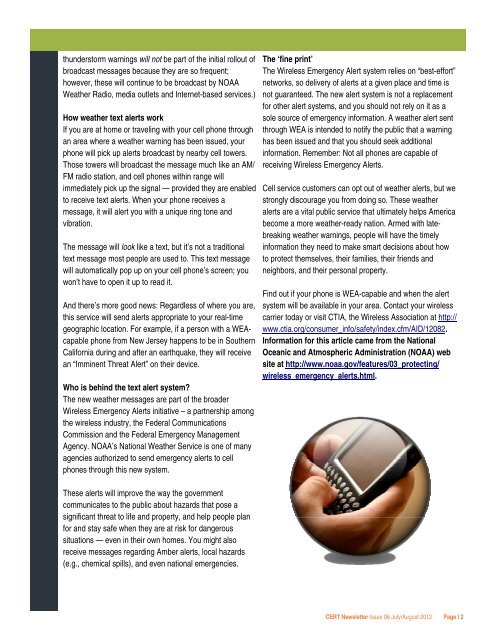CERT Newsletter - Issue 6 - July 2012
CERT Newsletter - Issue 6 - July 2012
CERT Newsletter - Issue 6 - July 2012
You also want an ePaper? Increase the reach of your titles
YUMPU automatically turns print PDFs into web optimized ePapers that Google loves.
thunderstorm warnings will not be part of the initial rollout of<br />
broadcast messages because they are so frequent;<br />
however, these will continue to be broadcast by NOAA<br />
Weather Radio, media outlets and Internet-based services.)<br />
How weather text alerts work<br />
If you are at home or traveling with your cell phone through<br />
an area where a weather warning has been issued, your<br />
phone will pick up alerts broadcast by nearby cell towers.<br />
Those towers will broadcast the message much like an AM/<br />
FM radio station, and cell phones within range will<br />
immediately pick up the signal — provided they are enabled<br />
to receive text alerts. When your phone receives a<br />
message, it will alert you with a unique ring tone and<br />
vibration.<br />
The message will look like a text, but it’s not a traditional<br />
text message most people are used to. This text message<br />
will automatically pop up on your cell phone’s screen; you<br />
won’t have to open it up to read it.<br />
And there’s more good news: Regardless of where you are,<br />
this service will send alerts appropriate to your real-time<br />
geographic location. For example, if a person with a WEAcapable<br />
phone from New Jersey happens to be in Southern<br />
California during and after an earthquake, they will receive<br />
an “Imminent Threat Alert” on their device.<br />
Who is behind the text alert system?<br />
The new weather messages are part of the broader<br />
Wireless Emergency Alerts initiative – a partnership among<br />
the wireless industry, the Federal Communications<br />
Commission and the Federal Emergency Management<br />
Agency. NOAA’s National Weather Service is one of many<br />
agencies authorized to send emergency alerts to cell<br />
phones through this new system.<br />
The ‘fine print’<br />
The Wireless Emergency Alert system relies on “best-effort”<br />
networks, so delivery of alerts at a given place and time is<br />
not guaranteed. The new alert system is not a replacement<br />
for other alert systems, and you should not rely on it as a<br />
sole source of emergency information. A weather alert sent<br />
through WEA is intended to notify the public that a warning<br />
has been issued and that you should seek additional<br />
information. Remember: Not all phones are capable of<br />
receiving Wireless Emergency Alerts.<br />
Cell service customers can opt out of weather alerts, but we<br />
strongly discourage you from doing so. These weather<br />
alerts are a vital public service that ultimately helps America<br />
become a more weather-ready nation. Armed with latebreaking<br />
weather warnings, people will have the timely<br />
information they need to make smart decisions about how<br />
to protect themselves, their families, their friends and<br />
neighbors, and their personal property.<br />
Find out if your phone is WEA-capable and when the alert<br />
system will be available in your area. Contact your wireless<br />
carrier today or visit CTIA, the Wireless Association at http://<br />
www.ctia.org/consumer_info/safety/index.cfm/AID/12082.<br />
Information for this article came from the National<br />
Oceanic and Atmospheric Administration (NOAA) web<br />
site at http://www.noaa.gov/features/03_protecting/<br />
wireless_emergency_alerts.html.<br />
These alerts will improve the way the government<br />
communicates to the public about hazards that pose a<br />
significant threat to life and property, and help people plan<br />
for and stay safe when they are at risk for dangerous<br />
situations — even in their own homes. You might also<br />
receive messages regarding Amber alerts, local hazards<br />
(e.g., chemical spills), and even national emergencies.<br />
<strong>CERT</strong> <strong>Newsletter</strong> <strong>Issue</strong> 06 <strong>July</strong>/August <strong>2012</strong> Page | 2


